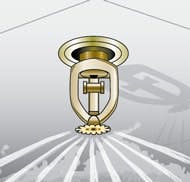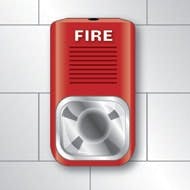Fire-Protection System Design
The design of any fire-protection system is an exact science that takes into account a building’s use, occupancy, footprint, and even its other installed systems.
“Fire-protection systems are complicated and sophisticated, and are different for just about every building,” notes Jeffrey E. Harper, engineering manager and vice president at Rolf Jensen & Associates Inc. (The RJA Group), an organization of fire-protection and security consultants based in Chicago. Every well-designed system, whether it is being designed for a new building or being installed as part of a renovation or retrofit, must be developed with specific objectives in mind.
Planning for fire protection involves an integrated approach in which system designers need to analyze building components as a total package. In most cases, the analysis needs to go beyond basic code compliance and the owner’s minimum legal responsibilities for providing protection.
“You need to look beyond a systems standpoint and examine, as a whole, how all the components work together,” notes Bruce Fraser, director of industry relations at SimplexGrinnell, Westminster, MA.
As Jeffrey L. Harrington, president and founder of Harrington Group Inc., a fire-protection engineering firm in Duluth, GA, notes, the design process should be a holistic one for both new construction and retrofits. Building ownership and management, architects, engineers, contractors, and consultants all need to be involved in the planning and design process, and fully understand the issues and concerns of all other parties.
Code Compliance
Code compliance is the first objective in any design. Codes are legal minimum requirements; you have to meet the minimum with any design.
“Sometimes you wind up with less protection than you should have; other times you end up with more,” Harrington says. “Compliance with building codes is like bandwidth. It gives you a broad-brush range that has to be applied to every single building in the jurisdiction. Sometimes it hits the mark and provides cost effectiveness and protection; other times it might not hit the mark.”
The additional challenge is that fire codes can vary substantially across the country, even within a state or county. “Take Chicago, for instance,” notes Donald Goosman, construction manager at Rolf Jensen. “You might manage one building in the suburbs and one in the city. The fire code could be very different between those two buildings. Even minor differences can have major implications on system design.”
Goosman and Harper say that when Rolf Jensen practitioners work with clients, they explain what the code requires, what they (as fire-protection engineers) recommend, and which options exist.
“New or retrofit, we suggest to the owners that they consider things [beyond] what the codes require,” Harper says. “We recommend going over and above if it ensures proper maintenance and enhanced life safety.”
Well-versed architects and engineers, as well as manufacturers’ representatives, will be able to guide you in determining if your system, new or retrofitted, should meet minimum code or go beyond the essentials.
The Basics
In the design process, these typical fire-protection system goals are on the table for consideration:
- Saving lives.
- Saving property.
- Preserving business continuity.
It all depends on how a building is used and occupied. A warehouse or storage facility, for example, will have different fire-protection requirements than a multi-tenant office building.
While no standard fire-protection design blueprint exists for any two buildings, the systems found in any building typically include these basic components:
- Detection.
- Alarms and notification.
- Suppression.
All components of modern fire-protection systems need to work together to effectively detect, contain, control, and/or extinguish a fire in its early stages - and to survive during the fire. To achieve the most beneficial symbiosis between these components, it’s best to involve an experienced system designer, such as a fire-protection engineer, in the early stages of the planning and design process.
Detection Systems
Modern smoke-detection systems go beyond the small device that senses smoke and triggers the alarm system. Intelligent smoke detectors can differentiate between different alarm thresholds. “The systems are getting smarter,” Harper says.
Heat detectors are another option. They can trigger alarms and notification systems before smoke even becomes a factor.
Specification and installation of detection systems can sometimes be selective. “You might not need it in some places,” Fraser notes. “It depends on if the building [is] occupied around the clock or if it goes unoccupied for periods.”
The main benefit of good detection (beyond triggering the alarm system) is that, in many cases, there is a chance to extinguish a small, early blaze with a fire extinguisher.
Alarms and Notification Systems
Alarm systems are a must in any facility - alarms that alert building occupants of a fire and alarms that alert emergency public responders (police and fire) through a central station link so they can initiate a response.
“Today’s systems have the ability to provide more information to the fire department and first responders,” Goosman notes. “In some cases, they can do more than just tell them that there has been an alarm in the building; they can be directed by the kind of alarm and where the alarm is.”
This can be achieved with AutoCAD floorplan integration. When an alarm goes off in a building and alerts the security or management team, an AutoCAD screen comes up on the computer, showing the floor where the alarm was activated and providing a computer print-out of that screen. Security can then hand the floorplan, which indicates the alarm zone, to first responders when they arrive. “[This] makes it easier to determine where the alarm is,” Goosman says. “Instead of just going to the 12th floor and looking for the alarm area, they know where to go.”
Many modern systems now include speakers that provide alerts in place of (or in addition to) traditional bell-type alarms. These speakers also can be used in emergencies other than fires to instruct and inform occupants of the situation.
These voice-actuated systems can include pre-recorded or live messages that play in the event of fire or another emergency. Typical pre-recorded messages tell occupants that an alarm has been sounded and that they should remain in their designated area for further instruction. Building management can then manually use the system to deliver additional information and prepare occupants for an evacuation, if necessary. “There’s a growing trend [where] the fire alarm system is being used for mass notification,” Fraser points out.
Alert systems can also close fire doors, recall elevators, and interface and monitor the installed suppression systems, such as sprinklers. “Code calls for it,” Harrington notes. “Every waterflow switch is connected to the building’s fire alarm system.”
The systems can also connect with a building’s ventilation, smoke-management, and stairwell-pressurization systems - all of which are critical to life safety. Again, these features are dependent on the building in which the system is installed.
“Not every system requires smoke control, but some systems absolutely would need it,” Fraser says. “Take a shopping mall, for instance. You would want to keep smoke contaminants and irritants away from people by moving the air for [about] half an hour to get people out of the area and evacuate them quickly and safely.”
Suppression Systems
Sprinklers are the most widely specified suppression system in commercial facilities - particularly in occupied spaces.
According to the Quincy, MA-based National Fire Protection Association (NFPA), the presence of sprinklers cuts the chance of death and average property loss from a fire by one-half to two-thirds as compared to scenarios where sprinklers are not present.
Despite a myriad of Hollywood scenes with a roomful of sprinklers activating and drenching occupants, that scenario is actually a myth when it comes to real fire protection, notes the Dallas-based American Fire Sprinkler Association (AFSA): Sprinkler heads are individually activated by fire.
Each independently operating sprinkler has a heat-sensitive element inside. These elements heat up to the sprinkler’s operating temperature and activate that sprinkler head. According to the AFSA, 90 percent of all fires are controlled by six or fewer sprinkler heads.
In situations where sprinklers aren’t feasible because of special considerations (e.g. water from sprinklers would damage sensitive equipment or inventory), designers might suggest an alternative fire-suppression system, such as gaseous/chemical suppression. Once more, experts note that the type of sprinkler used depends on the building’s function.
Harrington recalls a recent meeting with a client: The client opened a large retail store in a mall and didn’t use a consultant for fire-protection system design. In the back of the retail area, the space has two small rooms: One houses the store’s telecommunications and computer equipment, and the other houses equipment for a big-screen television display that entertains shoppers in the retail portion of the space.
The client installed gaseous suppression systems in both rooms, disconnected the sprinklers, and then called Harrington in to see if the system suited their needs - after it was installed.
“They wasted money on the gaseous system,” he says. “We could have optimized the cost by doing a risk assessment upfront. The risk was so low that, if there was an incident in the room, it didn’t warrant gas, which requires a high degree of sophistication from the staff to operate. In a retail environment, the existing sprinkler system would have been fine.”
Maintaining Safety
Beyond the components that actually make up an integrated fire-protection system, there’s another important factor that affects design: maintenance.
An improperly maintained system lacks reliability and, therefore, true protection. If a system is not maintained properly, its reliability degrades rapidly. Don’t install a system that you can’t routinely maintain and test easily and effectively.
“Designing and installing a system is one thing - maintaining it is another,” Goosman says. “Many systems become too difficult or too intricate to maintain. If not maintained properly, [they] will not work properly.”
And, they need to work. Case in point: A visible sprinkler tells building occupants that the building is protected. “If I’m in a building with sprinklers and I know that the sprinkler system is working, then I’m pretty safe,” Harrington says.
Robin Suttell ([email protected]), based in Cleveland, is contributing editor at Buildings magazine.


